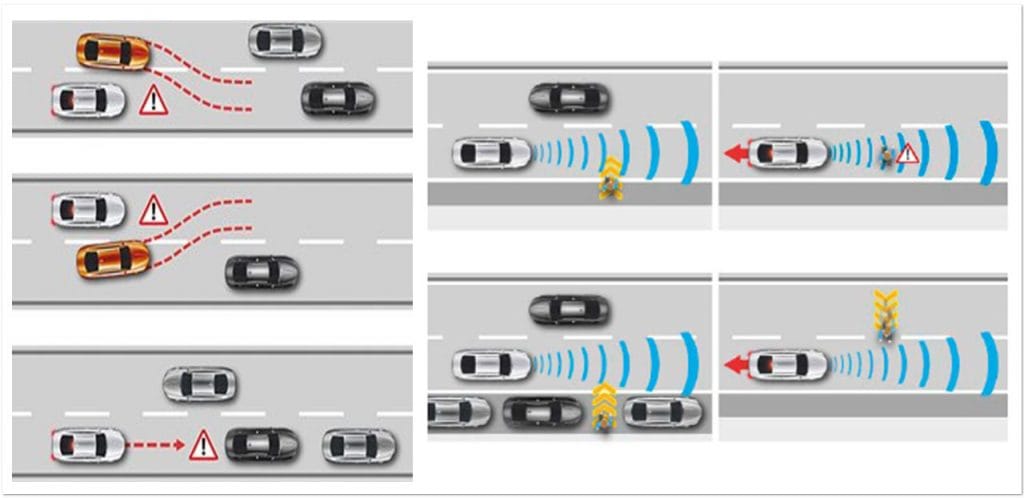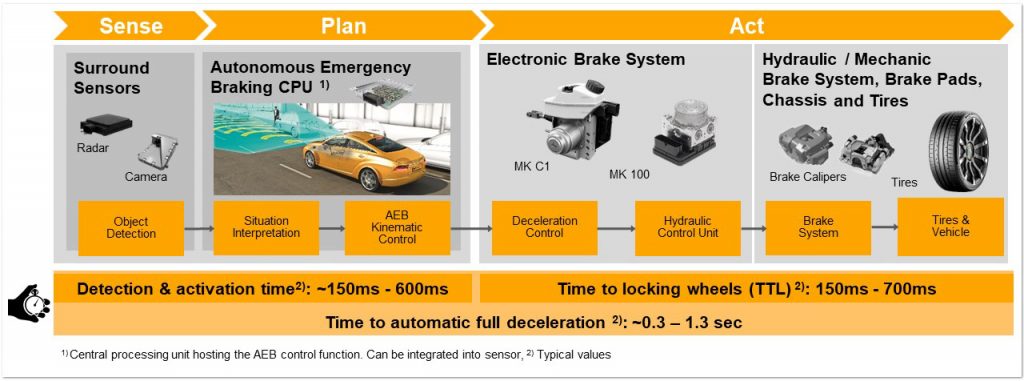Autonomous Emergency Braking
(AEB)
More than just a pure ADAS domain function
The AEB system is designed to avoid accidents utilizing driver visual/audible alerts as well as automatic partial and full-braking in a considerable number of scenarios. The AEB function may cascade various warning and braking stages as well as varying levels of deceleration.

AEB development began in 1973 to mitigate the number of severe traffic accidents. Since then, there is continuous innovation, which significantly increases active and passive safety effectiveness. Each of these innovations contributes to the continuous reduction of traffic accidents, as demonstrated by a decrease in fatal road accidents every year, despite a dramatic increase in road users over the same period.
Most of these safety-enhancing features initially worked as a stand-alone and driver-assisting system. Examples include the Anti-lock Brake System (ABS) and the Brake Assist System (BAS). However, with the further development of these features, the need for a system-spanning interaction also grew, and with it, the continued development of the Advanced Driver Assistance Systems.

In this environment, AEB functionality spans the limits of the individual vehicle domains and is expected to be mandatory by the EU General Safety Regulations by 07/2022.

AEB functionality is often reduced to its ADAS component alone. However, depending on the AEB generation considered, and taking into consideration the particular application, functionality usually has a much broader scope and interacts with far more vehicle domains than the feature name might suggest.

The expandability and adaptability of AEB make it possible to centrally control inter-vehicle interactions and thus to ensure an ideal and reliable functional sequence of events. The main component of this function is the interaction between the environment detection (Sens) of an implementation intelligence (plan) and a brake intervention (Act).
The following is a non-exhaustive list of functional interactions which can be incorporated into the operational flow described above:
- Driver monitoring
- Seat belt pretension
- Close windows
- Unlock doors
- Hazard warning lights actuation
- Transmission of an accident report

Our broad expertise in the full range of vehicle domains combined with our in-depth knowledge of the individual products and their development cycles gives us the unique capability to realize complex concepts and to successfully develop the entire field as well as features and functions outside traditional product limits.

With direct speed and velocity measurement, high range, independence from visual conditions and general high robustness against environmental influences, radar sensors are the backbone of environment perception.
Advanced Driver Assistance Systems (ADAS) are revolutionizing the driving experience by providing drivers with critical safety features that can help prevent accidents. One of the most important components of ADAS technology is camera sensors. Cameras are essential in providing real-time data for environment perception and safety.
CES provides consulting and turn-key solutions for fulfilling legal regulations, homologation and NCAP requirements
Today’s braking systems do more than “just” bring a vehicle to a standstill. They can also recover energy through recuperation, reduce CO2 emissions through intelligent driving and braking, and protect human life by shortening the braking distance even under adverse environmental conditions and when driving inattentively.
Systems Engineering is an interdisciplinary approach to develop highly complex systems. This means the transformation of an idea into vehicles.

